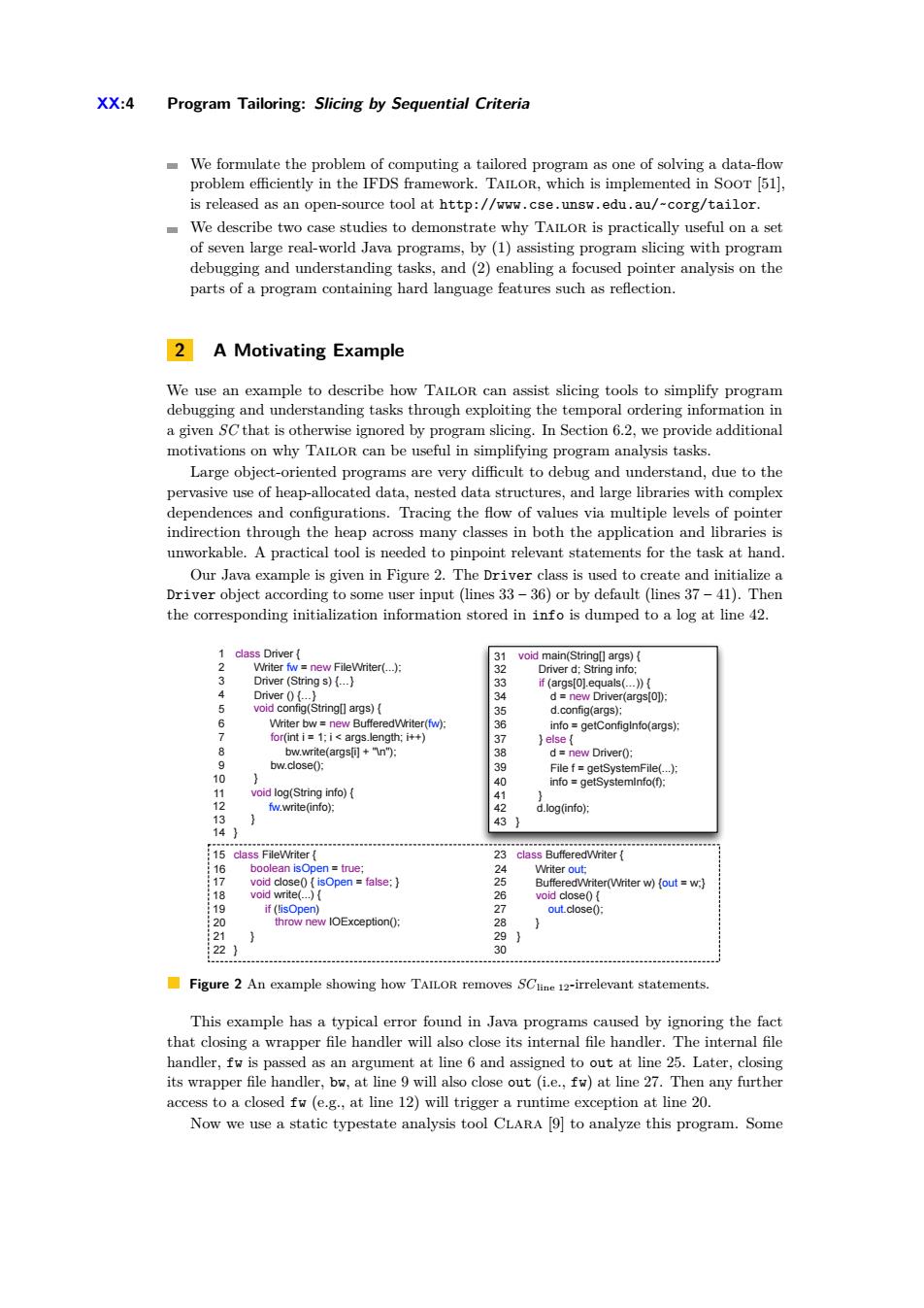正在加载图片...

XX:4 Program Tailoring:Slicing by Sequential Criteria We formulate the problem of computing a tailored program as one of solving a data-flow problem efficiently in the IFDS framework.TAILOR,which is implemented in Soor [51], is released as an open-source tool at http://www.cse.unsw.edu.au/~corg/tailor We describe two case studies to demonstrate why TAILOR is practically useful on a set of seven large real-world Java programs,by(1)assisting program slicing with program debugging and understanding tasks,and(2)enabling a focused pointer analysis on the parts of a program containing hard language features such as reflection. 2 A Motivating Example We use an example to describe how TAILOR can assist slicing tools to simplify program debugging and understanding tasks through exploiting the temporal ordering information in a given SCthat is otherwise ignored by program slicing.In Section 6.2,we provide additional motivations on why TAILOR can be useful in simplifying program analysis tasks. Large object-oriented programs are very difficult to debug and understand,due to the pervasive use of heap-allocated data,nested data structures,and large libraries with complex dependences and configurations.Tracing the flow of values via multiple levels of pointer indirection through the heap across many classes in both the application and libraries is unworkable.A practical tool is needed to pinpoint relevant statements for the task at hand. Our Java example is given in Figure 2.The Driver class is used to create and initialize a Driver object according to some user input(lines 33-36)or by default (lines 37-41).Then the corresponding initialization information stored in info is dumped to a log at line 42. 1 class Driver{ void main(String[]args){ Writer fw new FileWriter(..): 32 Driver d:String info; Driver (String s){...) if (args[o].equals(...)){ Driver0{】 3 d new Driver(args[o]): void config(String[]args){ d.config(args); Writer bw=new BufferedWriter(fw): info getConfiglnfo(args): > for(int i=1:i<args.length;i++) 3> else{ 8 bw.write(args间+"n: 3 d=new Driver(; bw.close(): File f getSystemFile(...): 10 } 4 info=getSystemlnfo(f): void log(String info){ fw.write(info); 2 d.log(info); 13 433} 4} :15 class FileWriter{ 23 class BufferedWriter{ 16 boolean isopen tre Writer out: 17 void close isOpen false; BufferedWriter(Writer w)fout w.} :18 void write(...){ 26 void close({ 19 if(isOpen) 27 out.close(): :20 throw new IOException(); 28 21 29} 221 30 Figure 2 An example showing how TAILOR removes SCline 12-irrelevant statements. This example has a typical error found in Java programs caused by ignoring the fact that closing a wrapper file handler will also close its internal file handler.The internal file handler,fw is passed as an argument at line 6 and assigned to out at line 25.Later,closing its wrapper file handler,bw,at line 9 will also close out (i.e.,fw)at line 27.Then any further access to a closed fw(e.g.,at line 12)will trigger a runtime exception at line 20. Now we use a static typestate analysis tool CLARA [9]to analyze this program.SomeXX:4 Program Tailoring: Slicing by Sequential Criteria We formulate the problem of computing a tailored program as one of solving a data-flow problem efficiently in the IFDS framework. Tailor, which is implemented in Soot [51], is released as an open-source tool at http://www.cse.unsw.edu.au/~corg/tailor. We describe two case studies to demonstrate why Tailor is practically useful on a set of seven large real-world Java programs, by (1) assisting program slicing with program debugging and understanding tasks, and (2) enabling a focused pointer analysis on the parts of a program containing hard language features such as reflection. 2 A Motivating Example We use an example to describe how Tailor can assist slicing tools to simplify program debugging and understanding tasks through exploiting the temporal ordering information in a given SC that is otherwise ignored by program slicing. In Section 6.2, we provide additional motivations on why Tailor can be useful in simplifying program analysis tasks. Large object-oriented programs are very difficult to debug and understand, due to the pervasive use of heap-allocated data, nested data structures, and large libraries with complex dependences and configurations. Tracing the flow of values via multiple levels of pointer indirection through the heap across many classes in both the application and libraries is unworkable. A practical tool is needed to pinpoint relevant statements for the task at hand. Our Java example is given in Figure 2. The Driver class is used to create and initialize a Driver object according to some user input (lines 33 – 36) or by default (lines 37 – 41). Then the corresponding initialization information stored in info is dumped to a log at line 42. class Driver { Writer fw = new FileWriter(...); Driver (String s) {…} Driver () {…} void config(String[] args) { Writer bw = new BufferedWriter(fw); for(int i = 1; i < args.length; i++) bw.write(args[i] + "\n"); bw.close(); } void log(String info) { fw.write(info); } } 1 2 3 4 5 6 7 8 9 10 11 12 13 14 class FileWriter { boolean isOpen = true; void close() { isOpen = false; } if (!isOpen) throw new IOException(); } } void write(...) { 15 16 17 18 19 20 21 22 class BufferedWriter { Writer out; void close() { } } out.close(); BufferedWriter(Writer w) {out = w;} 23 24 25 26 27 28 29 30 void main(String[] args) { Driver d; String info; if (args[0].equals(…)) { d = new Driver(args[0]); } else { } d.config(args); info = getConfigInfo(args); d = new Driver(); File f = getSystemFile(...); info = getSystemInfo(f); d.log(info); } 40 41 42 43 31 32 33 34 35 36 37 38 39 Figure 2 An example showing how Tailor removes SCline 12-irrelevant statements. This example has a typical error found in Java programs caused by ignoring the fact that closing a wrapper file handler will also close its internal file handler. The internal file handler, fw is passed as an argument at line 6 and assigned to out at line 25. Later, closing its wrapper file handler, bw, at line 9 will also close out (i.e., fw) at line 27. Then any further access to a closed fw (e.g., at line 12) will trigger a runtime exception at line 20. Now we use a static typestate analysis tool Clara [9] to analyze this program. Some